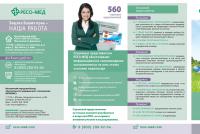Depreciation rate for the year formula. How to calculate the monthly depreciation rate in a linear fashion. What is the depreciation rate
Let's calculate the monthly depreciation rate:
K \u003d 100% \u003d 1.04%
Thus, monthly depreciation will be charged on the machine, equal to 1404 rubles. (135,000 1.04%).
As already mentioned, for tax purposes, depreciation can also be calculated using a non-linear method. To do this, the residual value of the fixed asset at the beginning of the month is multiplied by its depreciation rate. And in the first month of operation of the fixed asset, depreciation is calculated from its original cost. But, as noted above, after the residual value of the fixed asset becomes equal to 20 percent of its original cost, the procedure for calculating depreciation should change. In the next month, this residual value is taken as the base value and depreciation is calculated from it in equal shares (as in the linear method). This is stated in paragraph 5 of Art. 259 of the Tax Code.
The monthly depreciation rate is calculated using the formula:
 ,
,
where K is the rate of depreciation in percent;
n - term useful use fixed asset in months.
Example 2
In January 2002, OOO Pride purchased a computer for RUB 48,000. (including VAT - 8,000 rubles) and in the same month put it into operation. According to accounting policies The company calculates depreciation of fixed assets for tax purposes using a non-linear method.
The classification puts computers in the third depreciation group. Their useful lives can range from three years one month to five years inclusive. The organization has determined that the computer will last three and a half years (42 months).
Computer depreciation must be charged from February 2002. Its depreciation rate will be:

In February, 1,904 rubles will be depreciated. (40,000 rubles 4.76%), and in March - 1,813 rubles. ((40,000 rubles - 1,904 rubles) 4.76%).
So amortization will need to be charged until the residual value of the computer drops to 8,000 rubles. (40,000 rubles 20%).
In October 2004, the residual value of the computer will be 7,960 rubles. Therefore, from November 2004 until the end of the useful life (up to June 2005 inclusive, i.e. within 8 months), depreciation will need to be charged in the amount of 995 rubles. ( ![]() ).
).
The Tax Code establishes restrictions on the use of the non-linear method in relation to buildings, structures, transmission devices included in the eighth to tenth depreciation groups.
To compare linear and nonlinear methods, it is advisable to draw up a table depreciation chargeswhere you can graphically depict their dynamics.
Example 3
Let's take the following initial data to build the table: the initial cost of the fixed asset is 500,000; the useful life is 20 months. Accordingly, the depreciation rate for the straight-line method will be ![]() \u003d 5%, and for nonlinear -
\u003d 5%, and for nonlinear - ![]() = 10%.
= 10%.
| Linear method | Non-linear method |
||||||||
| Initial stand. | Useful term use | Initial stand. | we stand. | Useful term use | |||||
By increasing depreciation charges, this is a rather risky and laborious way of tax optimization. At the same time, practice shows that many people manage to increase the amount of depreciation deductions (or reduce the initial cost of the object) and thereby save income tax. Let us consider what methods of saving allow organizations to reduce income tax through depreciation and how risky their use is from a tax point of view in the article "Five easy ways to reduce income tax through depreciation."
It is determined by the accountant himself based on the useful life of the object according to the formula:
Note: since the depreciation rates are determined depending on the useful life of the object, and this period is determined by the so-called depreciation groups, in our table, the depreciation group is the initial indicator - this will make it easier for you to use the table.
Estimated depreciation rates for fixed assets by depreciation groups
Depreciation group |
Useful life of the fixed asset in years |
Useful life of the fixed asset in months |
Annual depreciation rate for accounting purposes (linear method, method of declining balance),% |
Monthly depreciation rate for tax accounting purposes (linear method),% |
|---|---|---|---|---|
|
The first group - all short-lived property with a useful life of 1 to 2 years inclusive |
||||
|
The second group - property with a useful life of more than 2 years to 3 years inclusive |
||||
|
The third group - property with a useful life of over 3 years to 5 years inclusive |
||||
|
The fourth group - property with a useful life of over 5 years up to 7 years inclusive |
||||
|
The fifth group - property with a useful life of over 7 years to 10 years inclusive |
||||
|
Sixth group - property with a useful life of over 10 years up to 15 years inclusive |
||||
|
Seventh group - property with a useful life of over 15 years up to and including 20 years |
||||
|
Eighth group - property with a useful life of more than 20 years up to 25 years inclusive |
||||
|
The ninth group - property with a useful life of over 25 years up to 30 years inclusive |
||||
|
Tenth group - property with a useful life of over 30 years |
The company determines the depreciation rate by dividing the original cost of an asset by its useful life. After that, there is a periodic transfer of previously incurred costs to current costs. The method is applied to fixed assets that lose their properties over time.
In accounting, the depreciation rate should reflect the planned useful life of the asset. In Russia, the regulatory tax rules have established groups of fixed fixed assets. For them, the depreciation rate is a predetermined value. Information about it can be found in the List of Annual Rates.
The classifier of fixed assets contains detailed information about the type of property and the recommended amount of depreciation rates. The main criterion for the depreciation group is the service life of the object. There are 10 categories of fixed assets. The first of them refers to objects whose regulatory use is limited to 1-2 years inclusive, the last one - over 30 years.
Features of the appointment of depreciation rates
Depreciation rates depend on:- The type of fixed assets. According to the legislation, a fixed asset is an asset acquired or created independently, which is owned or jointly owned by a taxpayer. Depreciation deductions in mandatory write off from the following categories of objects: buildings, structures and premises, machines, equipment and vehicle... Also, it can be other items with an estimated period of use of more than one year, used by a taxpayer for needs related to his business activities.
- Operating conditions of fixed assets. Legislated depreciation rates are based on average values. If the operating conditions imply accelerated physical wear and tear, the interest rate may be revised.
- Depreciation method. There are two write-off schemes. Linear - consists in establishing equal deductions throughout the entire period of use of fixed assets. Degressive - used for objects with uneven wear. Depreciation charges apply until the total purchase price is included in operating costs.
The taxpayer can individually determine the rate of depreciation rate, including for:
- used or improved fixed assets;
- first listed of this taxpayer objects;
- investments in foreign fixed assets;
- intangible assets.
What is the depreciation rate
The depreciation rate indicates how much of a particular asset can be repaid during the year. For example, a rate of 20% means that the amortization time is planned to be 5 years.The size of the standards used by the entrepreneur depends on the group of goods whose cost is covered by depreciation. For instance:
- residential building - the rate is 1.5-2.5%;
- mobile phones, cash registers - 20%;
- computer systems - 30%.
For each fixed asset, the concepts of depreciation and rates are applied.
The first term means a sequential process of transferring the value of an object to manufactured products, services to expenses.
The second is the percentage of the recoverable amount of the fixed asset, which depends on the useful life.
To understand the concept of depreciation rate, you need to understand the mechanism and meaning of the depreciation process.
Depreciation is an important process, because:
- directs cash flows to the reproduction of fixed assets;
- separates large investments by periods.
The rate is expressed as a percentage and shows what share of the cost of purchasing a fixed asset should be transferred to expenses and invested in the cost of production, goods, work during the year.
In other words, the norm is part of the cost of the OS, which the organization recognizes as expenses in reporting year.
What does it depend on?
The depreciation rate depends on the following parameters:
- Depreciation calculation method - affects both in accounting and tax accounting, below are the features of calculating the rate, depending on the method used.
- - in accounting it is set independently, in tax accounting in accordance with the depreciation group suitable for the fixed asset.
- Depreciation group - relevant only for tax accounting with a non-linear method of calculating depreciation, when the rate is set in accordance with the selected group.
By whom is the depreciation charge set?
In accounting the norms are not established, they are calculated by the accountant for each individual fixed asset, depending on the chosen method of calculating depreciation and the deadline service.
In practice, an annual rate is always calculated. An exception is the production method, in which the monthly rate is considered.
In tax accounting the norm is calculated only with the linear method of calculation, and its monthly size is always calculated.
This value is set at the legislative level with a non-linear method in tax accounting. There is no need to count anything. It is enough to determine the depreciation group for the fixed asset object, then from clause 5 of article 259.2 of the Tax Code of the Russian Federation, select the corresponding value of the norm.
How to calculate the annual percentage in accounting?
In accounting, the size of the average annual rate of depreciation is determined by the accountant independently. To do this, it is enough to set a suitable useful life for the fixed asset.
In addition, you need to decide on the applied method of depreciation. There are four of them in accounting -,.
The most clear definition and essence of the concept of depreciation rate is seen for the linear method.
Formula for the linear method(defined by clause 19 PBU 6/01):
Formula:
Annual N. \u003d 1 / SPI in years * 100%.
That is, this indicator is always expressed as a percentage.
Formula for diminishing balance method is distinguished by the introduction of a multiplying acceleration factor, which the organization takes independently within 3.
Formula for calculation:
Annual N. \u003d 1 * Ku / SPI with years * 100%.
For the method of writing off the cost in proportion to the volume of products, works, services, as well as for writing off according to the sum of the number of years of SPI, the rate is not calculated either on an annual or monthly basis.
Calculation example
The enterprise received a fixed asset, for which the useful life of 3 years (36 months) was selected in accounting and a linear method of calculation was established.
Annual N. \u003d 1/3 * 100% \u003d 33.33 percent.
How to determine the monthly value in accounting - formulas
The procedure for calculating the monthly rate depends on the selected method of calculating depreciation deductions.
For linear method the monthly indicator is not calculated, however, if necessary, it can be calculated as follows:
Formula:
Monthly N. \u003d 1 / SPI in months * 100%
The same way for diminishing balance method the calculation formula can be presented as follows:
Formula:
Monthly N. \u003d 1 * Ku / SPI in months * 100%
If the cost of a fixed asset is written off using the production method, that is, in proportion to the products produced or services performed, works, the monthly rate is not calculated. In this case, it is impossible to predict in advance what amount of depreciation deductions will be transferred to expenses for the year, since this indicator depends on the monthly production volume.
How to find it in tax accounting?
There are only 2 methods of depreciation in tax accounting:
- Linear - the monthly rate is calculated by dividing the unit by the useful life expressed in months. Further, the parameter is converted to percent.
- - the norm is set at the legislative level, depending on the depreciation group of the fixed asset, the current values \u200b\u200bof the monthly norm can be viewed in article 259.2 of the Tax Code of the Russian Federation, the annual parameter is not set.
Depreciation rate for groups of fixed assets:

In tax accounting for the received asset object, you should set a depreciation group, based on which the period of use is already selected.
Example
For the fixed asset there is a 3 depreciation group and a SPI equal to 60 months.
If the company uses the linear method, then the monthly rate will be 1.6667 percent (1/60 * 100%).
With a non-linear method, you need to look at Article 259.2 of the Tax Code of the Russian Federation, where a monthly rate of 5.6 percent is set for the 3 depreciation group.
conclusions
The depreciation rate is a concept that is used in both accounting and tax accounting. The indicator is always expressed as a percentage and shows what proportion of the value of the fixed asset will need to be transferred to the expenses of the organization for a certain period of time (year, month).
For accounting purposes, this value is always calculated on an annual basis, after which the annual depreciation amount is determined and then divided into 12 parts.
It's fast and free!
We talked about how the rates of depreciation deductions for intangible assets are established in ours. In this article we will tell you how to determine annual rate depreciation of fixed assets (OS).
How to calculate the annual depreciation rate for fixed assets?
The annual rate of depreciation of a fixed asset is a part of the cost of a fixed asset, expressed in fractions or percentages, which is recognized by the organization as depreciation expense in the reporting year.
Its definition is most obvious for a linear depreciation method. With this method, for the annual depreciation rate, the formula looks like this (clause 19 of PBU 6/01):
N \u003d 1 / SPIwhere N is the annual depreciation rate;
SPI - useful life (SPI) of an asset in years.
Accordingly, for an asset with a SPI equal to 10 years, the annual rate is 0.1 (1/10). This means that 1/10 part (or 10%) of the initial (replacement) cost of the fixed asset will be recognized annually as part of depreciation expenses.
With the method of decreasing balance to determine the annual amount of depreciation, the annual depreciation rate is multiplied not by the original or replacement cost of the fixed asset, but by its residual value. The annual rate itself is calculated as follows:
N \u003d K / SPIwhere K is the multiplying coefficient set by the organization (not higher than 3).
With the method of writing off the value by the sum of the number of years of useful life, the calculation does not imply the use of the depreciation rate at all. At least, such an indicator is not mentioned in the description of the procedure for calculating the amount of depreciation. Nevertheless, understanding the depreciation rate as the share of the cost of an asset subject to recognition in this year, for the annual rate of depreciation, the formula for this method can be represented as follows:
N \u003d CHL / ∑ CHLwhere CL is the number of years remaining until the end of the useful life of the asset;
∑CHL - the sum of the numbers of years of the useful life of the asset.
The amount of depreciation for the year with this method is determined by multiplying the rate by the original (replacement) cost of the asset.
During the year, depreciation is recognized monthly in the amount of 1/12 of the annual amount (clause 19 of PBU 6/01).
With the method of depreciation in proportion to the volume of production (work), the annual rate is not calculated at all. Indeed, with this option, the amount of depreciation is calculated based on the actual natural indicator of the volume of production (work) for reporting periodin which depreciation is determined. Since such an indicator cannot be calculated for the coming year, it will not be possible to determine the annual rate and calculate the amount of depreciation for the coming year.






